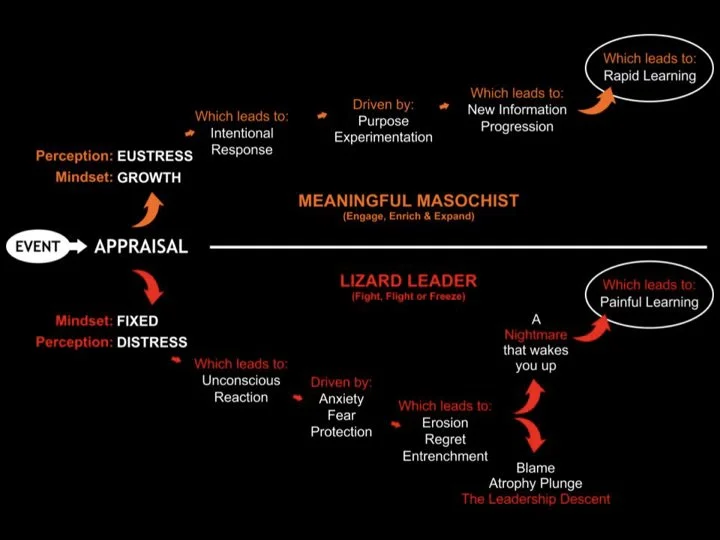The Tale of Two Leaders: The Appraisal Gap Behind Feedback
By Karas Wright, Certification Manager, Executive Leadership Coach, and Learning Support with Level 52.
The Tale of Two Leaders: The Appraisal Gap Behind Feedback
What if the same words could land as fuel for growth in one person and as a punch in the gut for another? Feedback, often touted as a cornerstone of leadership development, is not universally experienced. The way we interpret feedback is shaped long before we enter the boardroom. This is a story of two leaders. Both are high-performing, respected, and capable. Yet when it comes to feedback, they couldn’t be more different.
In my coaching work, I’ve sat with both kinds of leaders, one who thrives on feedback and one who flinches at it. They both want to grow. The difference is how they hear the message.
Their origin stories explain why.
Leader One: The Growth-Fueled Competitor
Raised in the high-performance world of competitive sports, Leader One was immersed in an environment where feedback was oxygen. It was immediate, direct, and always tied to improvement. Coaches framed critique as a way to level up. Mistakes were part of the process. Effort was rewarded.
This leader developed an internal narrative: feedback is coaching, and coaching is growth. Critique doesn’t bruise the ego; it builds the muscle. As an executive, this leader still seeks feedback proactively, often asking, “What could I be doing better?” They lean into discomfort because it’s where the learning lives.
They embody what Level 52 calls Meaningful Masochism, the ability to voluntarily enter discomfort in the service of growth. For them, feedback isn’t just welcomed; it’s mandatory. They tend to view stress as eustress, a positive challenge, and operate from a growth mindset that embraces experimentation and purpose-driven discomfort.
Leader Two: The Guarded High Achiever
Leader Two's experience with feedback was shaped in a different arena. In their formative years, feedback wasn’t about growth. It was used to control, correct, and withhold approval. Comments were laced with criticism, not curiosity. Mistakes weren’t learning moments; they were liabilities.
Over time, this leader internalized the idea that feedback equals threat. They learned to overachieve, anticipate needs, and avoid error to survive. They succeeded by staying ahead of criticism, not by engaging with it.
Today, this leader still carries that reflex. When feedback comes, even with good intentions, they experience a visceral response marked by defensiveness, withdrawal, and over-explaining. At Level 52, we call this the Lizard Leader (Reactive mode), the part of us wired for survival rather than growth. Their early experiences taught them to associate stress with distress, reinforcing a fixed mindset where safety, not stretch, becomes the goal.
Two Paths, Same Destination
Both leaders have climbed to impressive heights. However, their internal scripts about feedback create two very different reactions to the same input. One shifts into stretch, and the other into survival.
The critical moment isn’t the event itself; it’s the appraisal. How a leader interprets the event determines whether they step into growth or retreat into protection.
As coaches, peers, or senior leaders, we should not judge the reaction. It’s to understand the story behind it.
Of course, feedback doesn’t happen in isolation. Timing, tone, who gives it, and even the broader company culture play a role. A supportive environment can soften the reflex of a Lizard Leader and accelerate the momentum of a growth-focused one.
Importantly, we don’t live exclusively in one mode or the other. These aren’t fixed identities, but patterns that shift with context. Even the most feedback-hungry leaders can snap into protective mode when stakes are high or trust is low. Likewise, even the most guarded leader can move toward growth with the proper support and conditions. The key is recognizing the mode we're in and learning how to shift back to our best thinking.
Applying The Event-Appraisal Framework
Meaningful Masochism (Growth Mode):
Leader One thrives in stretch zones. They seek feedback, challenge, and discomfort because they associate it with growth.
Signals:
Proactively asks for feedback
Welcomes challenge
Reflects deeply and iterates quickly
Potential Outcomes if Unchecked:
Taking on too much, leading to fatigue or diminished focus
Risk of burnout from continuous self-imposed pressure
Mistakes from pushing past healthy capacity in pursuit of growth
Rapid learning if well-supported and resourced
Strategies to Support Growth-Oriented Leaders:
Balance push with pause. Encourage time for recovery and reflection.
Help them pace. Work together to identify what truly matters now.
Introduce checkpoints. Build in moments to assess before acting.
Offer well-rounded feedback by mixing stretch goals with recognition.
Reinforce identity beyond performance. Remind them they’re more than their output.
Reconnect them with purpose. Their drive is often fueled by experimentation and meaning, so tap into that to sustain momentum.
The Lizard Leader (Reactive Mode):
Leader Two slips into this mode when feedback touches an old wound. The threat isn’t the feedback itself; it’s what it represents. This leader goes into protective mode.
Signals:
Dismissiveness or defensiveness
Withdrawal or over-explaining
High control, low trust behaviors
Potential Outcomes if Unaddressed:
Poor decision-making driven by fear or avoidance
Increased likelihood of mistakes due to a lack of open dialogue
Overcommitting to prove worth or avoid scrutiny
Painful learning that reinforces entrenched behaviors
Strategies to support leaders in reactive mode:
Anchor feedback in psychological safety. Make the space safe, honest, and relationship-based.
Start with strengths. Help them feel seen for what they do well.
Use reflective questions. Ask “What feels helpful here?” or “What’s one thing you’d like to try?”
Offer micro-wins. Create small, achievable steps that let them test the waters without risk.
Celebrate progress. Highlight changes and shifts to rewrite their story around feedback.
Understand their motivation. Know that their resistance is driven by fear and the need for protection. Shifting the focus from fear to curiosity starts with safety.
Conclusion: Know the Feedback Narrative
Feedback isn’t just about performance. It’s about perception. Leaders don’t just hear it. They filter it through everything they’ve lived.
If we want to help someone grow, we must understand their feedback narrative. For one leader, that might mean fueling their fire. For another, it means building a safe place to land.
While they share the goal of effective leadership, they take different paths to achieve it, and constructive feedback can help them reach their objectives.


